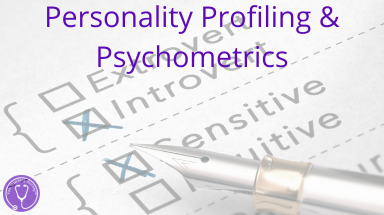Prefer to listen?
This blog post forms the basis of a podcast on our new coaching model, which you can listen to here.
It’s easy to think that everyone views the world in the same way that we do. Unfortunately, our map of the world isn’t the territory and someone else might have a completely different map. Personality and individual differences are a useful topic to explore with coachees.
In this article we explore the psychology behind a number of psychometrics that may prove useful in the coaching room.
Asking a coachee to complete a personality questionnaire and then working through their report with them can be a great way to increase their self-awareness and also their awareness of the individual personality differences that others might have.

Tom has a degree in psychology and is trained in a number of different psychometric profiling tools (including Myers Briggs – MBTI, Hogan, EQI, Belbin) so is well placed to steer this discussion and help us to gain some new insights about the topic.
Profiling has been around for a long time. Often attributed to Hippocrates, the Ancient Greeks had the idea of having four humours, which are ‘types’ of individual or characteristics that people have.
Modern profiling really started in the 1920s when they started to think about how someone’s personality could be assessed.
As an interesting aside, one of the early tests that was developed, DISC theory, was developed by the American psychologist and inventor William Marston, who also created Wonder Woman.
Currently there are two main theories of personality, one is type theory and one is trait theory.
Type theory
Type theory originates with Carl Jung. He had the idea of that we have four elements to our personality:
- Introversion – extraversion,
- judging – perceiving,
- intuition – sensing
- thinking -feeling.
So those were his four dichotomies or areas of personality. He believed you were either one or the other of these; either introvert or an extrovert, either judging or perceiving. Etc.
It was much more complex, but those were the four main areas, and that’s still a theory that is in existence today. MBTI is based on this theory, but it’s just one man’s theory. He wasn’t a researcher it was based on his observations. An awful lot of research has been done on the back of it to see whether it fits. The jury is still out on whether each of those elements are valid and whether you’re measuring what you say you’re measuring.
Trait theory
Trait theory looked at linguistics and the words we use to describe people. The researchers took thousands of words that we used to describe personality and boiled it down to five different elements:
- Extroversion
- conscientiousness,
- openness
- agreeableness
- neuroticism
And these are known as the big five in psychology
Those are the two sort of competing theories. A lot of academics will say type theory has no research backing to it, although there is a lot of research done by people that use type theory, but it does tend to follow on from the original concept rather than research that concept. Whereas trait theory is very much about the original concept and exploring, what describes people universally.
One of the other criticisms of type theory is it’s based on an individualistic western culture that doesn’t transfer well to more collectivistic eastern cultures, so, if you’re talking to someone in China about the different types, they might have a totally different understanding of what they mean.
If you try and map each element across the theories, they do map across quite well.
- Introversion and extroversion applies to both. Although in the big five, they just talk about extroversion, and you’re somewhere on a scale of extraversion. They don’t call the opposite introversion. So you would have high or low extroversion. Low extroversion would equate to being more introverted.
- Judging and perceiving is linked with conscientiousness. Judging people tend to be planful. They like to complete a task and move on to the next one, which is conscientiousness. People with a perceiving preference tend to be much more last minute, go with the flow, don’t really like to plan and would be low on the conscientiousness scale. It’s not a perfect match, but it does map quite well.
- Intuition and sensing maps quite well on to openness. Because if you’re open to the world, to new concepts, new ideas, that would suggest you have an intuition preference which is all about creativity and concepts, new ideas, and being comfortable with that. If you were low on openness, you’re probably more of a sensing, practical detail, person.
- Thinking and feeling tends to correlate with the agreeableness trait. If you’re high on agreeableness, you are likely to have a feeling preference, be interested in people, be empathetic. If you’re higher on thinking, you’d be lower on agreeableness and more task and goal focused. It’s more of a logical, analytical way of being.
The bit missing from type theory is the neuroticism scale. And this is tempered a little bit in some psychometrics, where they refer to ‘emotional stability’ rather than neuroticism. Which makes sense as neuroticism is quite a provocative term.
As much as there is that disagreement about whether the dimensions are valid and what’s actually being measured, both theories are pretty much in alignment.
What’s the best measure of personality?
If you are measuring any element of the big five, because it’s sort of academic, it’s very difficult to find a psychometric that does it well. It tends to become more complex than people want it to be.
What we’re trying to do in the coaching room is to increase people’s awareness of themselves If you’re talking to a coachee and trying to help them understand their personality, and you’ve got 16 different elements and you’re going through each one, they can get a bit lost. For example, ‘Hogan’ is quite complex to talk people through
Whereas, if you showed them something like an MBTI report, where there’s four dimensions to it, that might be more straightforward. To do an MBTI profile, they answer 87 questions and it gives them a score on each dimension. Some people complain that it puts them in a box. That’s not the intention, it’s just to give them a better awareness of themselves.
MBTI has a slight disadvantage in that it comes out with letters. We are both ENFP profiles. Extroverted, intuition, feeling and perceiving. So a bit more last minute. We know what it means, but some people remember the letters and that they’re introverted or extraverted, but they probably won’t remember much more beyond that.
There are some tools that almost oversimplify it. One of them is called Insights, it has some depth to it, but it tends to get used in a very superficial way. This takes two elements of the four from type theory and you end up as one of four personalities, fiery red or cool blue or earth green or sunshine yellow. This might sound familiar of you have come across DISC profiling.
These are all going to help raise the level of awareness of the individual about themselves, but also of the differences with other people. That’s where it’s really useful, that they recognise, that some people just do things differently.
Why do we have the expectation that everyone will see the world the way that we do?
If someone you know has got a different personality type, they’re definitely going to see the world differently to you and they’ll have different priorities, they’ll have different things that push their buttons. So, it’s really useful in terms of allowing people to understand that other people see the world differently and behave differently within the world.
It will also give them access to strengths that they perhaps didn’t know they had, and give them a language to be able to talk to others about their personalities with.
For example, if you’ve got someone who thinks they’re really shy and reserved who discovers that they are an introvert, that can say instead, ‘well actually I’m an introvert and I show up in this way because I’m an introvert’. That gives people a language to be able to communicate better.
Anything that increases people’s awareness and their ability to communicate is going to be useful.
We both know that there could be some gaps in our planning skills, but we are aware of that and we fill the gaps. We have to fill the gaps. So having that knowledge can be really useful.
Be aware though, these profiles are dependant on self-reported behaviour. If someone wants to manipulate it then they might well answer the questions in a way that supports the way they want to be seen by others.
So as a coach in the coaching room, how could we use this information?
Firstly, by inviting someone to do a personality profiling report. There’s lots of free versions available online so you’ll be able to find something that they can do.
It’s very difficult if you’ve not had any training for you to understand what’s being reported back. So it may be that if they do a personality test, asking them what they make of it is a good can opener to get someone talking about their personality,
If you’re interested in this area, do some studying around personality to become familiar with it so that you can have real conversations with people about their personality. Most of the personality profiles will give you a headline and unless you understand it, it’s difficult to hold that conversation with someone.
It’s really useful to use in the coaching room, but you have got to do a bit of work to get to the place of being able to use it well with a coachee.
In summary all personality profiling and psychometrics have merit, but they all have some problems. Really all we’re trying to do is help someone become more self-aware, and gain new perspectives on themselves and others, and the interactions and dynamics that come from relationships and working with others. As a coach, exploring the topic and learning more about your chosen tool will help you to help your clients understand themselves so much more.
To find out more about our Doctors’ Transformational Coaching Diploma click through here



